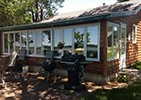Call us at: 320-839-6163













WINNER OF THE BERGARA B-14 300 WINCHESTER MAG RIFLE, donated by the Ortonville Independent was Kipp Stender of Madison at the Pheasants Forever Banquet held on Saturday, March 22. Kipp is shown above being presented his gun by Ortonville Independent Publisher Clarissa Blake.
City Council terminates lease agreement with Golf Clubhouse
The Ortonville City Council met for their second meeting of the month on Monday, March 17 at the library media center with all members present.
Bill Howell addressed the council on behalf of the request of the Park Board. He has a company that sets up stations for Self-Serve Sports Equipment. One of the stations that he sets up for is Kayak’s. All of the stations that he sets up are mobile and are mounted to drop-down trailer bases and are equipped with a Solar Powered Ventilation system. They have eight unit compartments.
After some discussion, the council passed a motion for Howell to put together a proposal for the next Park Board meeting.
A discussion was held on the recommendation by the Park Board to remove the hockey rink at the ice skating facility. A motion was made and seconded to have the hockey rink taken down.
Several members of the community were in attendance in favor of keeping the hockey rink. Work had been done to repair some of the boards around the rink. Those in favor of keeping the rink stated that if the hockey rink was fixed up, it would get used. The motion was then pulled and another motion made and passed to get estimates on what it would cost to repair the rink.
On the recommendation of the Park Board, a motion was made and passed to advertise for a part-time parks position.
Council members approved the Ortonville Deer Hunt request for 2025. The City Archery hunt will run from Sept. 13 through Dec. 31.
Jay Sammon was approved for part-time seasonal help at the Ortonville Golf Course.
A resolution approving the proposal and agreement with KLJ Engineering LLC for $4,000 for the runway construction design passed unanimously.
Mayor Gene Hausauer closed the regular session of the meeting at 5:45 p.m. to go into Executive Session to discuss the golf clubhouse. Mayor Hausauer then closed the executive session and called the regular council meeting back to order at 6:20 p.m. with no action taken during the closed session.
A resolution was passed with the City of Ortonville declaring default of the Alibi Lounge and Grill LLC (Alibi). The resolution states that the Alibi Lounge & Grill LLC entered into a lease agreement with the City of Ortonville (to lease the Ortonville Golf Course Clubhouse effective April 3, 2023 as Amended by the Amendment dated March 17, 2025 and whereas the Alibi Lounge & Grill LLC has breached the current lease agreement in many instances. These breaches include but are not limited as follows:
• Failure to provide inventory of equipment at the close of the golf season.
• As there was no heat in the building at times as a result of tenants’ failure to maintain fuel tanks with fuel, damage occurred to the premises. This violates paragraph nine of the original lease. The repair costs will include damage from the freezing pipes.
• Alibi owes one-half of pest control for services performed in 2023 and 2024 (paragraph 10 of the original lease).
• Alibi owes one-half of the telephone costs in 2023 and 2024 (paragraph 11 of the original lease).
• The liquor license is at risk because there are outstanding sales tax reporting that is delinquent. Licensee is unable to purchase from authorized liquor wholesalers. Further, the license may be revoked for failure to file returns and pay sales tax.
• It has failed to provide accounting for green fees and other golf-related income. The recordkeeping does not comply with reasonable business standards. The reports must be provided to the city which are timely, accurate and complete.
The Alibi was notified of the breach by the Ortonville Golf Board and an Agreement was provided to Alibi which provided an opportunity to cure the default and continue the relationship with the City. Alibi failed to accept the Agreement and failed to cure the defaults and the Golf Board has recommended that the lease be terminated pursuant to paragraph 21 of the lease agreement because of Alibi’s failure to cure the breach.
The City shall terminate the lease agreement as provided in paragraph 21 of the said lease for breach of the lease provisions as set forth.
The City Attorney shall take all steps to regain possession of the premises and retain possession of all personal property that belongs to the city pursuant to the lease agreement and the City of Ortonville as a result of contribution or money.
City Attorney shall attempt to collect money from Alibi.
The next meeting of the Ortonville City Council will be Monday, April 7 at 5 p.m. in the library media center.
School Board approves bussing contract with ATI for 2025-26
The Ortonville School Board met for their monthly meeting on Monday, March 17 at the Media Center with all members present.
Members of the Ortonville BPA team along with their advisor, Kim Johnson were on hand to highlight their season, recap the state event and preview Nationals. Students who gave the presentation were Norah Hartman, Braxton Brandriet, Kayla Zarate, Anika Olson, Morgan Haggerty and James Haugen.
“The students that attended the State Conference did a fantastic job,” said Johnson. “They represented their school well. Everyone should be very proud of all of them.”
Board members approved the following teaching contracts for the 2025-2026 school year:
• Nichole Cooper-Special Education
• Emily Breske-Special Education
• Jill Dale-High School Business and Computer.
The board approved a Head Football coaching contract for Matt Fellows for the 2025 season. Fellows is employed with the Ortonville School and has served as an assistant football coach with the North Dakota State College of Science in Wahpeton, ND.
Board members approved a contract for Kristy Moberg as an assistant volleyball coach. Moberg had been a long time head coach with the Clinton-Graceville-Beardsley (CGB) Wolverines.
Junior High softball contracts were approved for Ashley Wollschlager and Haley Jones for the 2025 season.
Jesse Roscoe was approved as the assistant golf coach for both boys and girls squads.
Board members accepted the resignation of Josh Zinski as Head Girls Basketball Coach. Zinski has served as the head coach the past three seasons. In his letter of resignation, Zinski thanked everybody that has supported the program.
A maternity leave request was approved for Makiah Sandberg, which will start on April 1 and go through the remainder of the school year.
At the school board meeting in February, board members reviewed options for transportation for the district’s routes and activities for the 2025-2026 year and beyond. The board approved a motion to get Requests For Proposals (RFP) with more detail on more buses for the March meeting.
During the meeting a lengthy discussion was held on considering the cost of adding on three new buses to make up for the three plus buses that have failed inspection or have been too costly to repair over the last two years as well as figures associated with subcontracting the transportation services to Aksamit Transportation, Inc (ATI).
Aksamit Transportation, Inc. President/Owner Mike Aksamit, his wife Jenny and daughter Katie Gaida were in attedance to give a brief presentation of their company and answer any questions.
Mike Aksamit stated that the current Ortonville bus drivers will be offered to join the Aksamit team. They currently operate fleets at CGB, Chokio-Alberta, and Browns Valley, which are the closest to Ortonville. They are headquartered in Long Prairie.
After a review of the costs not only currently, but also when projecting further down the road given factors like the age of the existing fleet remaining, the board moved to accept the proposal for ATI and the Ortonville School District to enter into a contract for transportation services to include all regular routes and activities starting in the 2025-2026 school year.
Board members approved a revised budget for the 2024-2025 school year. The revised budget shows an increase in expenses and revenues.
The board approved the 2025-2026 school calendar. School will start on Aug. 25, with the last student day on May 22, 2026.
Board members approved amending the school calendar for April 2, which was scheduled for an early out. With the revision, there will be no school for students that day, but will be a staff work day.
The board approved an update to Policy 413, Harassment and Violence. Some wording was changed in the policy.
The next meeting of the Ortonville School Board will be Monday, April 21 at 5:30 p.m. in the media center.






















